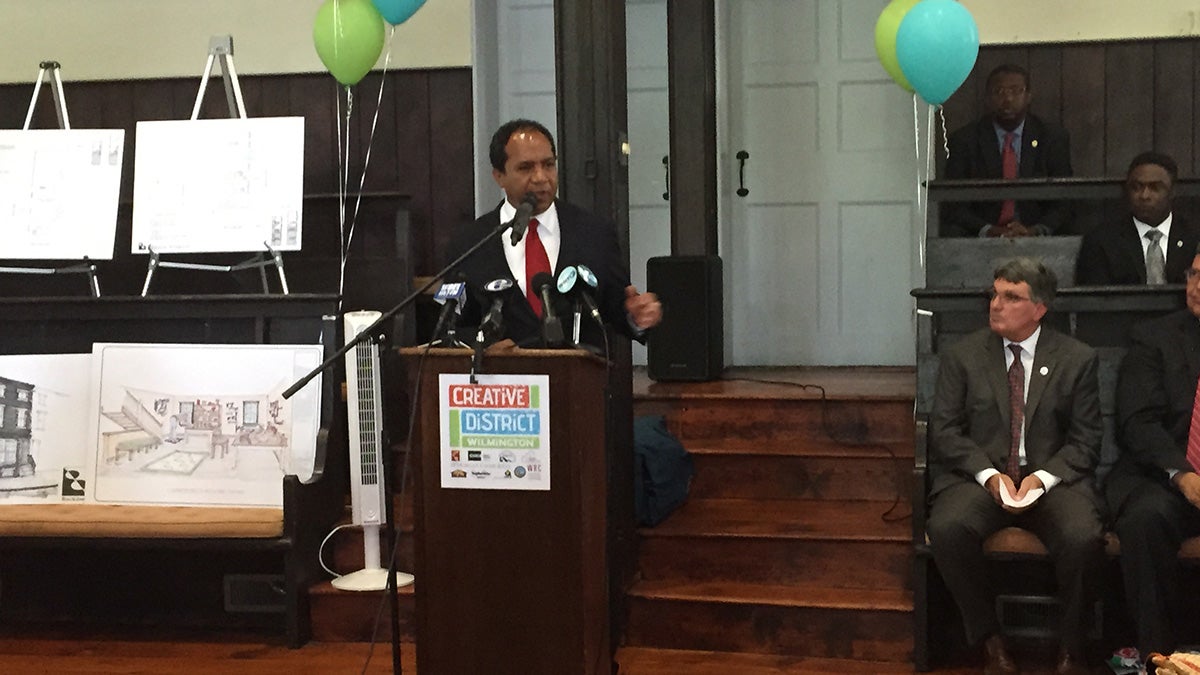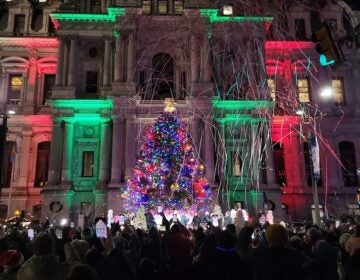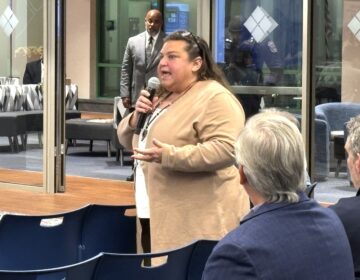Wilmington’s vacant properties to be converted into affordable homes for artists

Mayor Dennis Williams spoke during the launch of a project designed to renovate vacant homes into affordable housing. (Zoe Read/WHYY)
Wilmington plans to revitalize vacant, decrepit properties, into vibrant affordable homes where local artists can live and work.
New affordable homes, located in the Quaker Hill neighborhood of Wilmington, will be the city’s first housing development for artists, designed to eliminate vacant housing and provide affordable properties to the creative community.
The project, which is a collaboration between the Wilmington Renaissance Corporation and Interfaith Community Housing of Delaware, was announced in Wilmington Tuesday.
“It will have great interest and great demand for artists that want to come and live in a historic neighborhood and become part of the fabric of that neighborhood,” said Gary Pollio, executive director of ICHD, a non-profit organization focused on providing low and moderate income households in the community.
The project is part of Wilmington’s Creative District, which is focused on revitalizing Wilmington into a city where creative entrepreneurs and neighborhood residents flourish, and where locally designed goods and original works are created and consumed.
Several agencies, including the City, the Delaware State Housing Authority, JPMorgan Chase and the Quaker Hill Neighborhood, also are involved in the project.
The properties, known as the Willing Street Artist Village, will be located in the historic neighborhood of Quaker Hill, set between 5th and 6th streets and Washington and Willing streets.
Six vacant buildings will be converted into 10 redeveloped housing units as seven condos and three single family homes. Many of these properties were built in the late 1800s and haven’t been renovated in decades. Some are owned by banks and others are owned by the City of Wilmington.
While most urban affordable housing units are rentals, these properties will be owned. Prices are expected to be between $60,000 and $70,000 for one-bedroom condos and between $125,000 and $140,000 for single family homes.
The annual income for single individuals can be as low as $27,000, and for a family of four it cannot exceed $98,000.
The units will offer one, two and three bedroom options with 850 to 1400 square feet. All will have separate studio spaces so artists can both live and work in one property.
The project, which is supported by several private and public sector agencies, is expected to begin next month and be completed within a year.
When artists are brought into a community, the neighborhood thrives economically and culturally, said Carrie Gray, managing director for WRC, a non-profit organization focusing on revitalizing downtown Wilmington.
“The long term vision is not only to have vacant buildings now filled, but you would also have life on the street, energy on the street, activities, murals, and public art that adds to the energy and sense of place in the neighborhood,” she said.
Anas Ben Addi, director of the Delaware State Housing Authority, said it’s important to revitalize vacant housing because it affects the properties around it. He said surrounding properties will face a 5 to 10 percent decrease of home value.
“This project really does what it’s supposed to do, which is turn dilapidated vacant properties that were once positive assets for the community, turn them from negative assets back to being another positive asset, and help increase property value, help public safety and help economic development,” he said.
Mayor Dennis Williams, D-Wilmington, said the City plans to renovate 167 more properties in Wilmington if it receives funding.
“Any time you see construction going on, concrete being poured, buildings being renovated, the city is well alive,” he said.
“When the artists come in here, these are people who are going to be working, bringing customers in, and it’s just good all the way around for us.”
Gov. Jack Markell said during Tuesday’s announcement that he sees tremendous growth in the revitalization of Wilmington, and that he expects an increase in the next few years.
“If you look back 10 years ago, lower Market Street was all boarded up. Today lower Market Street is vibrant. The progress is unbelievable,” he said.
“If we manage to roll up our sleeves, check our egos at the door and get work done we’re going to see more of this.”
WHYY is your source for fact-based, in-depth journalism and information. As a nonprofit organization, we rely on financial support from readers like you. Please give today.





